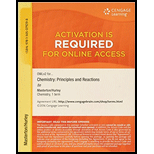
Concept explainers
(a)
Interpretation:
The formula and the name of the compound which is formed after the reaction of potassium with nitrogen should be determined.
Concept introduction:
A compound refers to a substance which contains definite proportion of two or more elements joined together through
(b)
Interpretation:
The formula and the name of the compound which is formed after the reaction of potassium with iodine should be determined.
Concept introduction:
A compound refers to a substance which contains a definite proportion of two or more elements joined together through chemical bonds. A chemical formula depicts the number of atoms of each element present in a compound. It consists of symbols of each of the atoms present in the given compound as well as how many atoms of each element are present in the compound are denoted by a subscript.
(c)
Interpretation:
The formula and the name of the compound which is formed after the reaction of potassium with water should be determined.
Concept introduction:
A compound refers to a substance which contains definite proportion of two or more elements joined together through chemical bonds. A chemical formula depicts the number of atoms of each element present in a compound. It consists of symbols of each of the atoms present in the given compound as well as how many atoms of each element are present in the compound are denoted by a subscript.
(d)
Interpretation:
The formula and the name of the compound which is formed after the reaction of potassium with hydrogen should be determined.
Concept introduction:
A compound refers to a substance which contains definite proportion of two or more elements joined together through chemical bonds. A chemical formula depicts the number of atoms of each element present in a compound. It consists of symbols of each of the atoms present in the given compound as well as how many atoms of each element are present in the compound are denoted by a subscript.
(e)
Interpretation:
The formula and the name of the compound which is formed after the reaction of potassium with sulfur should be determined.
Concept introduction:
A compound refers to a substance which contains definite proportion of two or more elements joined together through chemical bonds. A chemical formula depicts the number of atoms of each element present in a compound. It consists of symbols of each of the atoms present in the given compound as well as how many atoms of each element are present in the compound are denoted by a subscript.
Want to see the full answer?
Check out a sample textbook solution
Chapter 20 Solutions
CHEMISTRY:PRIN.+REACTIONS-OWLV2 ACCESS
- Heparin is used as an anti-coagulant. A risk of heparin use is thrombocytopenia, or low platelet count. This risk is minimized with the use of low molecular weight heparins (LMWH), therefore it is desirable to separate LMWH from higher molecular weight heparins. The method of choice to do this is molecular exclusion chromatography. Below is a chromatogram from a molecular exclusion chromatographic run. Peaks ranging from A to J are clearly distinguishable. The heparin mixture that was analyzed had anywhere from 6 to 30 repeat units of monomer (where the heparin with 30 repeat units would be roughly five times the size of the heparin with six repeat units). a. Which letter most likely represents the peak with 6 repeat units given these heparin polymers were separated with molecular exclusion chromatography? b. Explain your reasoning describing the mechanism of retention in molecular exclusion chromatography. 100 80 60 60 Relative Abundance 40 40 E GH 20 20 B A 36 38 40 42 44 46 48 50 50…arrow_forwardHELP NOW PLEASE ! URGENT!arrow_forwardHELP NOW PLEASE ! URGENT!arrow_forward
- Draw a Newman projection for the molecule below from the perspective indicated. Which of the groups (letters A-H) are methyl groups? CH3 H H H A H B ☑ >> H. ABCDEFG I H -H CH3 G D CH F E Numeric 4 points How many gauche interactions exist in the conformation shown in the previous problem? 1arrow_forwardHELP NOW PLEASE ! ASAP! URGENT!arrow_forwardHELP NOW PLEASE ! ASAP! URGENT!arrow_forward
- Would the following organic synthesis occur in one step? Add any missing products, required catalysts, inorganic reagents, and other important conditions. Please include a detailed explanation and drawings showing how the reaction may occur in one step.arrow_forwardPls help.arrow_forward13) When solid barium phosphate is in equilibrium with its ions, the ratio of barium ions to phosphate ions would be: a. 1:1 b. 2:3 c. 3:2 d. 2:1 14) The pH of a 0.05 M solution of HCl(aq) at 25°C is 15) The pH of a 0.20 M solution of KOH at 25°C isarrow_forward
 Chemistry: Principles and ReactionsChemistryISBN:9781305079373Author:William L. Masterton, Cecile N. HurleyPublisher:Cengage Learning
Chemistry: Principles and ReactionsChemistryISBN:9781305079373Author:William L. Masterton, Cecile N. HurleyPublisher:Cengage Learning Chemistry: Principles and PracticeChemistryISBN:9780534420123Author:Daniel L. Reger, Scott R. Goode, David W. Ball, Edward MercerPublisher:Cengage Learning
Chemistry: Principles and PracticeChemistryISBN:9780534420123Author:Daniel L. Reger, Scott R. Goode, David W. Ball, Edward MercerPublisher:Cengage Learning Chemistry: The Molecular ScienceChemistryISBN:9781285199047Author:John W. Moore, Conrad L. StanitskiPublisher:Cengage Learning
Chemistry: The Molecular ScienceChemistryISBN:9781285199047Author:John W. Moore, Conrad L. StanitskiPublisher:Cengage Learning Chemistry by OpenStax (2015-05-04)ChemistryISBN:9781938168390Author:Klaus Theopold, Richard H Langley, Paul Flowers, William R. Robinson, Mark BlaserPublisher:OpenStax
Chemistry by OpenStax (2015-05-04)ChemistryISBN:9781938168390Author:Klaus Theopold, Richard H Langley, Paul Flowers, William R. Robinson, Mark BlaserPublisher:OpenStax Chemistry & Chemical ReactivityChemistryISBN:9781337399074Author:John C. Kotz, Paul M. Treichel, John Townsend, David TreichelPublisher:Cengage Learning
Chemistry & Chemical ReactivityChemistryISBN:9781337399074Author:John C. Kotz, Paul M. Treichel, John Townsend, David TreichelPublisher:Cengage Learning Chemistry & Chemical ReactivityChemistryISBN:9781133949640Author:John C. Kotz, Paul M. Treichel, John Townsend, David TreichelPublisher:Cengage Learning
Chemistry & Chemical ReactivityChemistryISBN:9781133949640Author:John C. Kotz, Paul M. Treichel, John Townsend, David TreichelPublisher:Cengage Learning





